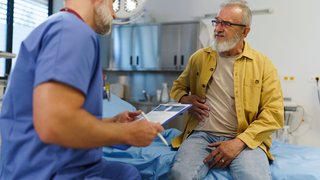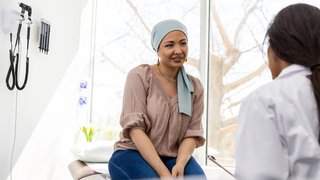Cancer rehab helps patients survive and thrive
April 22, 2025

Patients with cancer are asked to handle a lot of change – rearranging their lives to accommodate appointments, looking and feeling different in their clothes, and trying to keep up with everything when their energy is zapped.
During and after cancer treatment, between 60% and 90% of patients also will deal with at least one physical mobility or health limitation due to the disease, and more than half will have trouble with daily tasks such as cooking or doing chores.
For many patients, treatment-related symptoms such as nerve pain, bone fragility, and limited range of motion can last several months or even years without proper treatment from a cancer rehabilitation expert.
Though effective therapies are available, fewer than 10% of patients get personalized treatment to maximize their quality of life. Most downplay treatment-related symptoms. You may feel pressured to act brave or tough despite uncomfortable limitations. It might seem like wanting comfort is in direct conflict with how you “should” feel after surviving cancer: You’re “lucky to be alive,” and chronic pain is “a good trade-off for beating cancer.”
I’m here to tell you that feeling grateful to be alive and feeling physically miserable are not mutually exclusive. If your cancer is in a good place but your quality of life is not, wanting to feel better does not make you a burden – it is the next natural step to living the life you want to lead after surviving cancer.
You can get that kind of personalized care through the UT Southwestern outpatient Cancer Rehabilitation program at the Harold C. Simmons Comprehensive Cancer Center. Our multidisciplinary team brings together expertise in the nuances of high-quality survivorship and advanced assessment technologies, including:
- Oncologists who specialize in nearly every type of cancer and treatment.
- Physical Medicine and Rehabilitation (PM&R) specialists with extensive knowledge in neurologic and musculoskeletal medicine.
- Electromyography technology to find the root causes of nerve pain and desensitization.
- Injections to block nerve pain caused by cancer or treatments.
- Specialized counseling for patients who have had cancer.
Cancer rehabilitation is a growing field that helps patients thrive after cancer treatment, not just survive. We separate and treat layered challenges associated with cancer, cancer treatment, aging, and other underlying conditions. Our goal is to address the root cause of what’s holding you back and help you feel better at any stage of treatment or survivorship.

Getting to the root of what’s wrong
Cancer rehabilitation untangles the knot of what hurts and where, what’s causing your discomfort, and how we can help you feel better. For most patients, this isn’t a 15-minute assessment – you’ll have our full attention for as long as it takes to improve your symptoms.
The first step is for us to listen to you. Don’t be shy – we want to know how you personally define “quality of life.” This might be getting back to a favorite hobby, exercising again, going back to your career, or being able to do household tasks without pain. We’ll also review your health history and talk with your oncologists to understand how your cancer progressed and the treatments you endured.
Then we guide you through functional assessments. We’ll ask you to show us where you feel pain or discomfort and what movements cause those symptoms. Our PM&R specialists have deep knowledge in body mechanics, such as how deficits on one side of the body can lead to new problems on the other.
We’ll also evaluate your energy and ability to do specific things during your daily life, such as:
- Fatigue or weakness that limits activity
- Difficulty with dexterity, coordination, or balance
- Difficulty swallowing or speaking
- Changes in memory, attention span, or ability to focus
- Mood changes
- Sleep habits
- Nutrition and exercise
- Range of motion
- Problems with returning to work or any normal activities of daily living
When we put all these variables together, we get a wider and closer look at your personal changes and challenges. This allows us to identify connections – and create solutions – for specific problems like these that spot assessments can’t catch.
Rehab options for cancer patients
Neuropathy: Electrodiagnostics
Neuropathy is a chronic condition in which nerve damage leads to pain, numbness, tingling, or weakness. This can happen when a tumor presses on a nerve, or if a nerve is damaged due to cancer treatment or an unrelated condition, such as traumatic injury, diabetes, and some types of arthritis.
Neuropathic pain arises from many different types of muscle fibers, and any of these can be involved with your symptoms. To trace the nerve symptoms to the source, we use ultrasound and electrodiagnostic testing such as:
- Nerve conduction studies: We apply small electrical shocks to specific nerves and record their signals to see how well information travels along a nerve.
- Electromyography: A thin needle is inserted into several areas of specific muscles to record electrical activity.
In some cases, research has shown that blocking sensation to specific nerves can relieve symptoms, even while patients are taking chemotherapy. Some patients may benefit from massage therapy or surgery to decompress dysfunctional nerves.
Radiation fibrosis: Botox injections
Radiation fibrosis occurs when the soft tissues – nerves, blood vessels, skin, muscles, and connective tissues – around the radiation therapy site become inflamed, gradually tightening into scar tissue that can cause pain, swelling, spasms, and limited movement.
Botox can relax muscle tissue to help restore function and desensitize affected tissues to relieve discomfort. Physical and occupational therapy, massage, and laser surgery can also break down and loosen scar tissue in some patients.
Bone fragility: Custom orthotics
Radiation therapy can weaken bone near the treatment site, and some types of chemotherapy can cause bone fragility by reducing calcium levels. Aromatase inhibitors, a common medication to treat breast cancer, can also reduce bone density.
Lower bone volume can change how you walk, which can cause musculoskeletal injuries such as fractures or joint and muscle pain due to overcompensation. Bone fragility can increase the risk of a fracture from a fall. The Cancer Rehabilitation team can assess your gait – how you walk and move – and work with an orthotics specialist to recommend a properly fitted device.
Kinesiophobia: Personalized support
Kinesiophobia is a fear of movement that might lead to pain or further injury. It’s a common barrier after cancer treatment, which can cause fatigue and pain in unexpected places.
Cancer rehab experts are trained to recognize the signs of kinesiophobia, which can include avoiding specific movements or moving unnaturally, such as tightening up. These can lead to lost stamina, additional pain, and prolonged functional limitations.
Your care team will adapt your rehab plan so you feel comfortable and confident. We may recommend supportive services such as psycho-oncology care along with specific exercises to improve flexibility and strength.

Special cases in breast cancer
Patients who’ve had breast cancer have complex needs that affect several different body systems. About 68% of women struggle with symptoms after mastectomy such as chest wall tension, swelling, brachial plexopathy (a type of upper body nerve dysfunction), or limited range of motion in the shoulders.
Treatment-related problems sometimes masquerade as other conditions. Here are two common concerns that we frequently identify and resolve for patients who’ve had breast cancer:
- Chest wall pain and tight skin: After mastectomy, discomfort and limited range of motion in the upper body is often blamed on scar tissue or nerve damage. But it’s often because the chest muscles become very tight, pulling the shoulders, head, and neck painfully inward. Targeted stretching can reduce pain and help improve range of motion.
- Armpit discomfort or swelling: This is often attributed to lymphedema, swelling after a lymph node is removed or damaged. If massage therapy only helps temporarily and swelling returns, the cause may be nerve-related. We can often treat this with targeted nerve blocks.
Back to living the life you love
It’s incredible to witness patients flourishing after rehab. Many tell us that we are the first providers to listen without judgment, to lay hands on them and understand where their pain travels, and to take a personal interest in helping them feel better.
Cancer has disrupted your life enough! We want to help you thrive, not just survive. Personalized rehabilitation therapies can help you regain the physical and emotional vigor to return to the activities you love, take care of your family, and live the life you want.
To talk with an expert about oncology rehabilitation, make an appointment by calling 214-645-4673 or request an appointment online.











